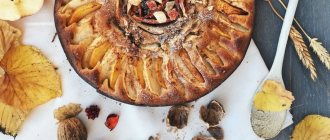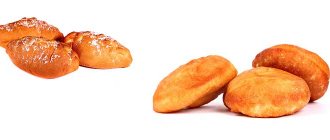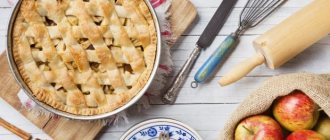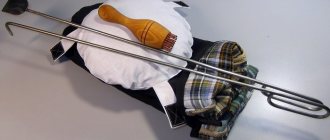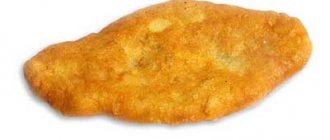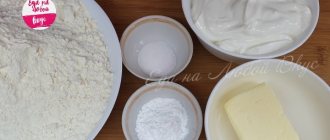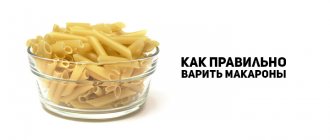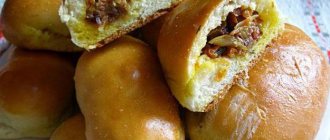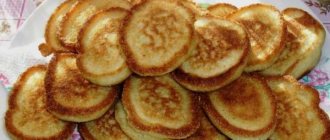Puff pastry is a base product for baking. It produces light, crispy textured products. Puff pastries are suitable for creating both sweet cookies and vegetable and meat pies.
Currently, a wide range of ready-made dough is available on store shelves: chilled, frozen. Each of the semi-finished products has its own characteristics and composition, but the key components in it remain unchanged. This is butter or margarine, water, flour.
In small doses, baking from puff pastry is harmless. Due to the abundance of fats in the composition, it quickly saturates, serves as the main source of energy, and forms protective layers for internal organs. The benefits of a product depend on the original ingredients from which it is made.
Properties of puff pastry
Nutritional value and composition | Vitamins | Minerals
How much does puff pastry cost (average price per 1 kg)?
Moscow and Moscow region.
96 rub.
Quite often, many housewives use puff pastry to prepare a variety of culinary and confectionery products. Pies, cakes, puff pastries with sweet fillings and more - the choice of dishes is truly multifaceted. Compared to some other types, the calorie content of puff pastry is significantly higher and amounts to approximately 337 kcal per 100 grams. In this regard, dishes that contain this product should not be abused by people with increased body weight.
In general, puff pastry products are the thinnest layers of dough that are quite easily separated from each other. They are crispy on top and tender and soft on the inside.
Cooking recommendations
To obtain airy baked goods, you need to follow simple rules:
- To make the dough elastic, salt and vinegar are added to it. It is important to be careful so that the taste of the product does not deteriorate. For 400 g of flour you should take no more than 15 ml of 9% vinegar;
- To get a golden crust, you need to grease the top of the product with a chicken egg;
- It is necessary to use premium flour. Before use, it is sifted;
- When cutting, a carefully sharpened knife is used;
- To make light products, alcohol is added to them, for example, vodka or cognac, no more than 15 ml per 400 g of flour.
- There must be cooling at every stage.
- Cold water is used in the batch.
- It should be rolled out correctly.
- Butter or margarine is applied cold.
If you follow these rules, you get a delicious puff pastry. This does not change the calorie content per 100 grams.
Composition of puff pastry
Regarding the composition of puff pastry, we can say that its main components are wheat flour, water, butter and salt. By the way, sometimes, for example, instead of butter you can see margarine, which is why the calorie content of puff pastry may vary slightly. This dough, which serves as the basis for baking crispy, crispy products, requires special attention and precision in the process of its preparation.
Depending on the ingredients that make up the puff pastry, this product is usually divided into 2 types: classic and simplified version. Undoubtedly, classic puff pastry has a higher quality of finished products, but it is also quite difficult to prepare. That is why many housewives prefer to buy a ready-made store product.
If you decide to make your own puff pastry at home, remember that to prepare the classic version, you first need to knead a soft dough, which consists of flour, water and salt, and then roll cold butter into it in thin layers. The more such layers, the correspondingly higher the quality of the dough. Experts say that the best puff pastry has approximately 140 layers. Sometimes these numbers can reach up to 240! It is almost impossible to distinguish these thin layers with the naked eye, and preparation requires a lot of time, but believe me, it is worth it.
If you still don’t dare and opt for ready-made ice cream puff pastry, do not forget that here you need to follow some rules. First of all, the dough must thaw on its own. If it has been frozen in layers, they should first be separated from each other and then thawed individually for about 20 minutes. Thawed layers of puff pastry are moistened with cold water, stacked and rolled into a single layer to the desired thickness and size.
You need to roll out the dough with a rolling pin, and there are also some tricks here: first from right to left, then vice versa, then from bottom to top and top to bottom, that is, always in the same direction. This is done so that the layers are not damaged and the finished product rises during baking.
Puff pastry is usually baked on a baking sheet, which is pre-moistened with cold water, and not greased with oil as usual. This is done based on two considerations: firstly, during the baking process, the water evaporates, giving the dough additional volume. And secondly, the fat (butter or margarine) that is part of the product significantly increases in volume during baking, thereby releasing the water dissolved in the dough. Due to the fact that the liquid turns into steam, the layers rise, separating from each other, resulting in the process of stratification of the dough.
Yeast addition
Yeast is often added to puff pastry, but this is not necessary. The baked goods rise during the cooking period. Yeast influences the occurrence of physicochemical and enzymatic reactions. Elasticity, porosity, structure, taste and aroma depend on these processes.
If the dough will be frozen, then add more yeast than usual. This is due to a decrease in gas-forming effect. Often compressed yeast is used for this. Only they cannot be used dry. Such a product will be resistant to cooling.
It is advisable to choose fresh, pressed yeast from foreign companies that have stamps of microcultures that affect fermentation. This product will be active even in the presence of additives, baking acids, as well as after freezing and storage.
Calorie content of butter dough per 100 grams
The calorie content of rich yeast dough per 100 grams is 226 kcal. In 100 g of this product:
- 6.5 g protein;
- 2.1 g fat;
- 48.2 g carbohydrates.
Recipe:
- Place 33 g of fresh raw yeast in a bowl, knead with 1 tablespoon of sugar;
- Pour the resulting mixture with a few tablespoons of warm milk. Grind everything thoroughly;
- add a few tablespoons of flour to the yeast mixture, mix until smooth, leave to steep for 5 - 15 minutes;
- pour 670 g of flour into a bowl, make a hole in the flour, pour 4 tablespoons of sugar, a teaspoon of salt, a little vanillin into the hole, pour in 0.5 liters of warm milk, a quarter cup of vegetable oil and the yeast mixture;
- mix the dough thoroughly with a spoon;
- coat your hands with vegetable oil and knead the dough again;
- Place the dough in a bowl greased with vegetable oil, cover with film, and leave to rise for 1 hour.
Calorie content of puff pastry without yeast. Chemical composition and nutritional value.
Nutritional value and chemical composition of “yeast-free puff pastry”.
The table shows the nutritional content (calories, proteins, fats, carbohydrates, vitamins and minerals) per 100 grams of edible portion.
| Nutrient | Quantity | Norm** | % of the norm in 100 g | % of the norm in 100 kcal | 100% normal |
| Calorie content | 377 kcal | 1684 kcal | 22.4% | 5.9% | 447 g |
| Squirrels | 5.5 g | 76 g | 7.2% | 1.9% | 1382 g |
| Fats | 21.9 g | 56 g | 39.1% | 10.4% | 256 g |
| Carbohydrates | 39.5 g | 219 g | 18% | 4.8% | 554 g |
| Organic acids | 38.3 g | ~ | |||
| Alimentary fiber | 1 g | 20 g | 5% | 1.3% | 2000 g |
| Water | 35.8 g | 2273 g | 1.6% | 0.4% | 6349 g |
| Ash | 0.5 g | ~ | |||
| Vitamins | |||||
| Vitamin A, RE | 100 mcg | 900 mcg | 11.1% | 2.9% | 900 g |
| Retinol | 0.1 mg | ~ | |||
| Vitamin B1, thiamine | 0.09 mg | 1.5 mg | 6% | 1.6% | 1667 g |
| Vitamin B2, riboflavin | 0.06 mg | 1.8 mg | 3.3% | 0.9% | 3000 g |
| Vitamin B4, choline | 30.4 mg | 500 mg | 6.1% | 1.6% | 1645 g |
| Vitamin B5, pantothenic | 0.2 mg | 5 mg | 4% | 1.1% | 2500 g |
| Vitamin B6, pyridoxine | 0.1 mg | 2 mg | 5% | 1.3% | 2000 g |
| Vitamin B9, folates | 14.5 mcg | 400 mcg | 3.6% | 1% | 2759 g |
| Vitamin B12, cobalamin | 0.07 mcg | 3 mcg | 2.3% | 0.6% | 4286 g |
| Vitamin E, alpha tocopherol, TE | 6.7 mg | 15 mg | 44.7% | 11.9% | 224 g |
| Vitamin H, biotin | 1.2 mcg | 50 mcg | 2.4% | 0.6% | 4167 g |
| Vitamin RR, NE | 1.5794 mg | 20 mg | 7.9% | 2.1% | 1266 g |
| Niacin | 0.6 mg | ~ | |||
| Macronutrients | |||||
| Potassium, K | 71.2 mg | 2500 mg | 2.8% | 0.7% | 3511 g |
| Calcium, Ca | 17.3 mg | 1000 mg | 1.7% | 0.5% | 5780 g |
| Silicon, Si | 2.1 mg | 30 mg | 7% | 1.9% | 1429 g |
| Magnesium, Mg | 9.1 mg | 400 mg | 2.3% | 0.6% | 4396 g |
| Sodium, Na | 50.2 mg | 1300 mg | 3.9% | 1% | 2590 g |
| Sera, S | 46.3 mg | 1000 mg | 4.6% | 1.2% | 2160 g |
| Phosphorus, P | 53.2 mg | 800 mg | 6.7% | 1.8% | 1504 g |
| Chlorine, Cl | 603.6 mg | 2300 mg | 26.2% | 6.9% | 381 g |
| Microelements | |||||
| Aluminium, Al | 552.1 mcg | ~ | |||
| Bor, B | 19.5 mcg | ~ | |||
| Vanadium, V | 47.3 mcg | ~ | |||
| Iron, Fe | 0.7 mg | 18 mg | 3.9% | 1% | 2571 g |
| Yod, I | 1 mcg | 150 mcg | 0.7% | 0.2% | 15000 g |
| Cobalt, Co | 1.2 mcg | 10 mcg | 12% | 3.2% | 833 g |
| Manganese, Mn | 0.3034 mg | 2 mg | 15.2% | 4% | 659 g |
| Copper, Cu | 61.3 mcg | 1000 mcg | 6.1% | 1.6% | 1631 g |
| Molybdenum, Mo | 8.1 mcg | 70 mcg | 11.6% | 3.1% | 864 g |
| Nickel, Ni | 1.5 mcg | ~ | |||
| Tin, Sn | 5.3 mcg | ~ | |||
| Selenium, Se | 3.2 mcg | 55 mcg | 5.8% | 1.5% | 1719 g |
| Titanium, Ti | 5.8 mcg | ~ | |||
| Fluorine, F | 13.7 mcg | 4000 mcg | 0.3% | 0.1% | 29197 g |
| Chromium, Cr | 1.5 mcg | 50 mcg | 3% | 0.8% | 3333 g |
| Zinc, Zn | 0.475 mg | 12 mg | 4% | 1.1% | 2526 g |
| Digestible carbohydrates | |||||
| Starch and dextrins | 35.6 g | ~ | |||
| Mono- and disaccharides (sugars) | 1 g | max 100 g | |||
| Sterols (sterols) | |||||
| Cholesterol | 19.2 mg | max 300 mg |
The energy value of puff pastry without yeast is 377 kcal.
Primary Source: Created in the application by the user. Read more.
** This table shows the average levels of vitamins and minerals for an adult. If you want to know the norms taking into account your gender, age and other factors, then use the “My Healthy Diet” application.
Properties and calorie content of yeast dough
Yeast dough is prepared using special culinary yeast, which, when interacting with flour and water, is capable of forming abundant bubbles of carbon dioxide. Thanks to this, it turns out tall, fluffy and soft. In addition to the main ingredients, sugar, dried fruits, milk and various fats are also sometimes added to the dough, which increase the calorie content of yeast dough, so you should not abuse such additives.
Yeast dough can be bread and butter, as well as prepared in a sponge or straight way. The last method allows you to spend less time preparing the dough, but it does not always guarantee the expected result. The calorie content of yeast dough always depends on its composition, however, if you do not use additional additives, then on average this figure is about 230 kcal per 100 g. This figure is quite high, but this does not mean that a small amount of dough cannot be used in your diet at all .
Calorie content of biscuit dough per 100 grams
The calorie content of biscuit dough per 100 grams is 288 kcal. 100 g contains:
- 6.8 g protein;
- 7.7 g fat;
- 52.4 g carbohydrates.
To make biscuit dough, you need:
- Pour 4 chicken eggs at room temperature into a mixer bowl, add a pinch of salt to the eggs. Beat the resulting mixture at high speed;
- add 1 cup of sugar in several additions, beat the dough thoroughly;
- sift 1 cup of flour into a bowl;
- add flour into the egg mixture in parts, not forgetting to mix the dough with a spatula;
- the finished dough is poured into a baking dish greased with vegetable or butter;
- bake the biscuit in a preheated oven for 35 - 40 minutes at a temperature of 160 degrees.
Cherry puff pastry in a slow cooker
- 250 g puff pastry;
- 250g cherry jam (pitted);
- 5 teaspoons starch;
- a pinch of powdered sugar
From the jam, you need to strain the berries and pulp, then mix them with starch until a thick consistency is obtained.
Spread the cherry filling evenly on top of the rolled out thin layer of dough, then roll the dough into a roll, pressing the edges well.
Place the roll in a spiral in the greased bowl of the multicooker and turn on the “Warming” mode for 15 minutes, during which the dough will completely rise
Baking puff pastry in a multicooker is carried out in the “Baking” mode for 30 minutes on one side and the same amount of time on the other.
To give the roll a finished look, you can sprinkle it with powdered sugar and decorate with mint or lemon balm leaves.
Calorie content of shortcrust pastry per 100 grams
The calorie content of shortcrust pastry per 100 grams is 400 kcal. In 100 g of product:
- 6.4 g protein;
- 21.7 g fat;
- 49.8 g carbohydrates.
Shortcrust pastry recipe:
- Place 200 g of softened butter, a pinch of salt, and half a glass of sugar in a mixer bowl. Beat at medium speed until smooth;
- Add 1 whole egg and 1 egg yolk to the resulting mixture. Beat for another 1 minute;
- knead the dough with a mixer with 2 cups of flour;
- Knead the dough laid out on the table a little with your hands.
Calorie content of curd dough per 100 grams
The calorie content of curd dough per 100 grams is 286 kcal. In a 100 gram serving of the product:
- 10 g protein;
- 13.2 g fat;
- 31.6 g carbohydrates.
A simple recipe for making curd dough:
- In a bowl, thoroughly mix 300 g of cottage cheese with a blender;
- add 200 g of softened butter to the cottage cheese;
- mix the ingredients thoroughly until smooth;
- add 1 tablespoon of sugar, a third of a teaspoon of salt, 10 g of baking powder;
- mix everything thoroughly;
- sift flour into the dough in parts (the total amount of flour will be 300 g), not forgetting to mix everything periodically;
- knead the dough, wrap it in film and put it in the refrigerator for 40 minutes.
Cooking features
The composition of yeast-free puff pastry includes:
- Melange.
- Lemon acid.
- Powdered milk.
- Cold water.
- Flour.
- Flour improver.
- Margarine or butter.
Everything is placed in the bowl of the dough mixing apparatus. The procedure takes up to 20 minutes. You should get a homogeneous mass. Then she lies in a cool place. The yeast base is prepared using a similar recipe. A mandatory step is to roll out the dough until a layer of 1-2 mm is obtained. Then it is folded in layers for 20 minutes. Then the procedure is repeated.
Semi-finished products are molded, frozen, and packaged in special packaging. The duration of storage is determined by the correctness of production. Typically this period is 5-60 days at temperatures down to -20 degrees. After defrosting, the product can be used to create baked goods.
